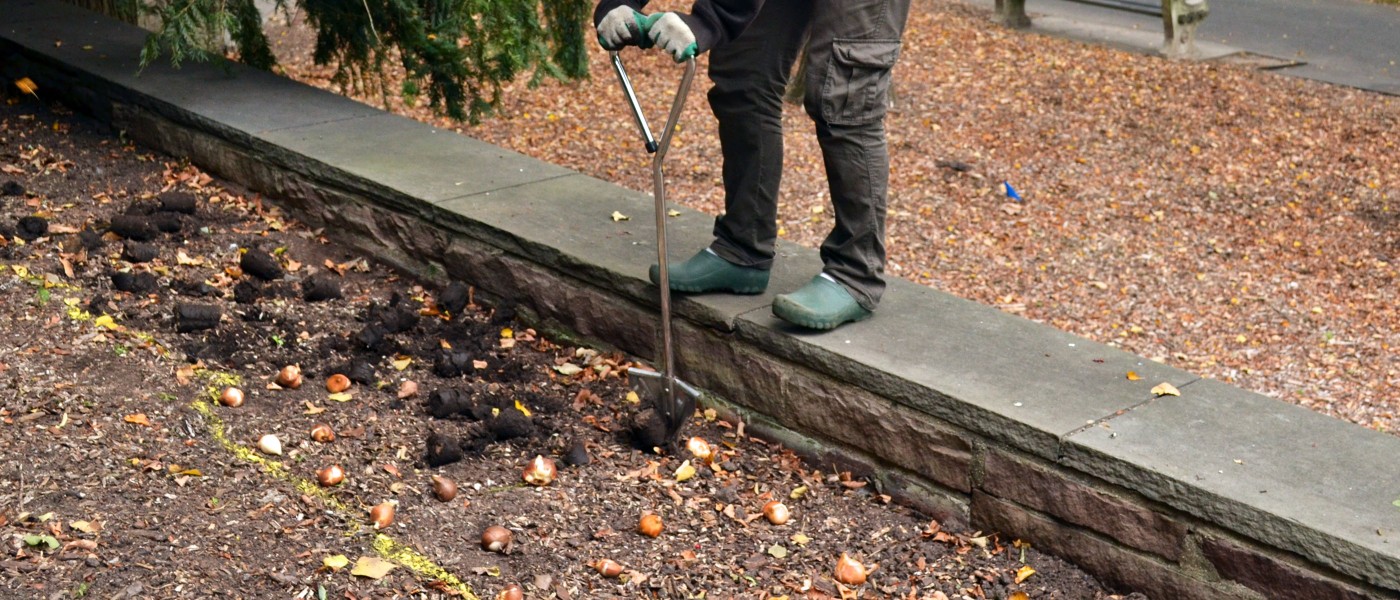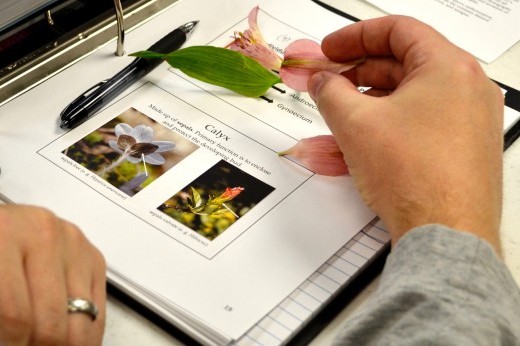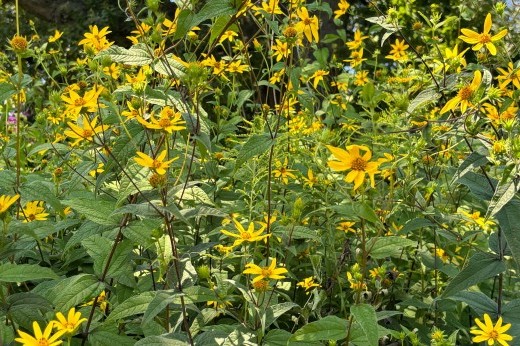Every March through November, a group of seasonal gardeners joins the staff to support Brooklyn Botanic Garden during its busiest nine months.
A day in the life of a seasonal gardener can be varied, from planting and watering, to mulching and mowing, to working with volunteers and seeing how BBG gardeners organize their day and prioritize their tasks. Seasonals, many early in their horticulture careers, assist and learn from gardeners in all parts of the Garden, from the conservatories to more naturalistic areas.
“We really depend on and are grateful for their support, and hope that it’s mutually beneficial,” says Shauna Moore, director of Horticulture. “It’s an opportunity for them to explore where they might want to focus in their horticulture careers.”
Education is part of BBG’s mission, Moore adds, and applicants come in with a range of experience levels. “I look for someone who really wants to be here and has a deep desire to learn.”
Below, three of BBG’s nine seasonal gardeners—Moe Fata, Dylan Smith, and Emily Symonds—share their most memorable experiences at BBG, their advice for people interested in careers in horticulture, and, most importantly, their favorite weed.
How did you get into horticulture?
Moe: Growing up in New York, I’d never even seen a tomato plant. Toward the end of college, I started looking into nutrition and health, and it led me to plants. A lot of people don’t know that their food comes from plants, and that was very inspiring to me. We’ve lost that connection between plants and our food and our health.
I listened to a TED talk by Ron Finley, and he was doing something called guerrilla gardening or gangsta gardening. He inspired my journey into permaculture. I remember he talked about living in a food desert, where there is a lack of plants, lack of nutrition, lack of connection between plants and people.
I got most of my horticulture experience in Florida. I started working at a nursery and learned the ropes. I learned how to do conventional gardening, spraying chemicals, which is not my preference. I moved on to other nurseries, which were also fairly conventional.
This is not on my resume, but I’ve also done a lot of guerrilla gardening in places like canals, gas stations, areas that people don’t maintain. And at my mom’s house in south Florida, I grew nine different varieties of spinach, sugarcane, bananas, papaya, a lot of things that BBG has in the Conservatory.
I eventually started my own company in Florida, and won an award in 2019. I was looking for what New York had to offer, and I found BBG.
Dylan: I was working at a restaurant in the East Village around the time of the pandemic, and was looking to make a transition out of that. You know, that’s a crazy culture, up all night, never seeing daylight, essentially. And that was starting to get to me.
I ended up moving upstate with a group of friends and found work with a gardener, and I worked for him for four years. So he kind of taught me the ropes. And I learned that I loved to work outside during the daytime. It was a lot better for me.
I moved back to the city in 2023 and started doing rooftops and backyards. I think private horticulture, because it’s for-profit, is more about doing as much as you possibly can as fast as you can. It’s just different work. And so when I found this seasonal gardener opportunity on MetroHort, I was relieved to know that this type of horticulture position exists. It’s still high intensity work, but the focus is on making the best decisions for the Garden.
Emily: I studied environmental science, and there was always this interest in being outside and talking about plants or green things. Once I got out of college, through a connection with the research group that I was in, I started working for the New York Restoration Project in their Sherman Creek Park area, which is awesome. And then I transferred into the community garden section and worked in their Brooklyn community garden branch, which was also so much fun.
After that, I went to California and worked on a farm and studied herbalism as well as sustainable agriculture and no-till soil practices. And then coming back to Brooklyn, this year, I landed the gig that I’m in now. I feel really inclined to work with plants. I think my biggest interests are in native plants, edible plants, and medicinal plants.
What’s an average day like for you at Brooklyn Botanic Garden?
Emily: We’re on a rotating schedule, which means we work with two gardeners at a time and we’re in a different section of the Garden every four weeks. Right now, I’m with Jenny Blackwell in the Discovery Garden and Wayken Shaw in Lily Pool Terrace and Magnolia Plaza. So we show up and check in with our gardener, and usually we get moving pretty fast.
In the morning we’re often prepping for the Garden to open to the public. So that could mean watering, especially in areas that get water on the path, because you can’t have those going during the day. Once the public is in, we transition to projects for the day, from invasive removal and weeding, which is very common, to doing some planting.
Dylan: It really is so incredibly varied day to day. Phil [Macaluso, foreperson of grounds] emphasizes the educational aspect of it, so he slows everything down and teaches us how to work the machinery safely. I’ve done everything from unloading topsoil from box trucks to learning the Latin names of asters with Jesse Brody.
Moe: Today in the Native Flora Garden we were chopping down pine needles and creating mulch to acidify the soil for blueberry shrubs, because blueberries love acidic soil. My favorite task so far was probably working in Belle’s Brook, clearing out organic matter. I’ve installed ponds and I know all the work that goes into water features. It’s a very tough job, but it’s satisfying, too, it’s interesting.
Any other favorite tasks?
Dylan: Looking for mugwort in the Native Flora Garden meadow with Will Lenihan. I would get to enter the meadow, tall goldenrod up to my eye level, and just get down and search for mugwort and bindweed while learning from Will. He was really working hard at weed suppression, and I learned a lot of different ways you can do that successfully. We were pulling specific types of asters that he didn’t want in the garden and putting them down as straw to suppress bindweed. It’s like a closed circuit, ecologically, and it was fascinating to see that.
Emily: I got to plant rice in the Herb Garden. That was a first for me. And I loved working on the mow crew, which handles turfgrass-related responsibilities. In the beginning of June, on my first day of mow crew, we found a Pride flag on the ground and strapped it to the mow truck. It’s still there! It was a really wonderful, silly, inclusive space.
Do you have any advice for people who are interested in a career in horticulture?
Moe: I would say find what you like and don’t be afraid to mess up. Also, there are a lot of different things you can do with horticulture. My passion is edible and medicinal plants, but someone else’s passion could be rose gardening, or it could be native flora. So try to focus on your passion, but if life takes you to a different garden, be open to it.
Emily: Something that is really important for me living in such a big city is being outside and working with plants. I feel a natural pull to it. There are a ton of people out there who are creating really wonderful projects and opportunities in horticulture. A lot of it is volunteer or seasonal; there aren’t that many full-time paid positions out there. But my hope is that it continues to grow, especially as green space continues to be, hopefully, more prioritized in the city.
For people who are interested in the field, just finding people to talk about it with is really useful. Volunteering is great. Finding organizations that you connect with and talking to them. The horticulture and green space world is a small network, and you can very quickly start to tap into it and hopefully start making a bunch of connections.
Dylan: The most surprising thing that I found is that the people in the industry are really rad nerds. I feel like I found my people. They’re cool, sweet, nerdy people who are really good at what they do. I didn’t expect to bond so hard with the other seasonals, but it really felt like the beginning of a Netflix show.
For anyone who doesn’t have a degree in horticulture, I recommend saving up and taking Horticulture Certificate courses at BBG. I’m in the botany class right now. It’s been really helpful on a practical level, and I’ve also heard that the certificate goes a long way when applying to work in gardens around the city.
Lastly—what’s your favorite weed?
Moe: My favorite weed is purslane (Portulaca oleracea). In my own garden, I don’t consider it a weed. It has high levels of omega-3 fatty acids, which is pretty rare for plants. I would pickle it or just eat it raw.
Dylan: Bindweed (Convolvulus arvensis). Apparently convolvulus means “entwined” and arvensis means “of the field,” which is exactly what bindweed does in real life—wrapping around the stalks of plants and overwhelming them, almost pulling them down.
Emily: Definitely mugwort (Artemisia vulgaris). It’s everywhere, it’s super aggressive. It’s really hard to get rid of. But it’s also a medicinal plant, and it’s known as a dream herb, or an herb that enhances dreams. In the horticulture world, everyone’s shaking their fists at it. But I think it’s right on. I think it’s a total rebel.



